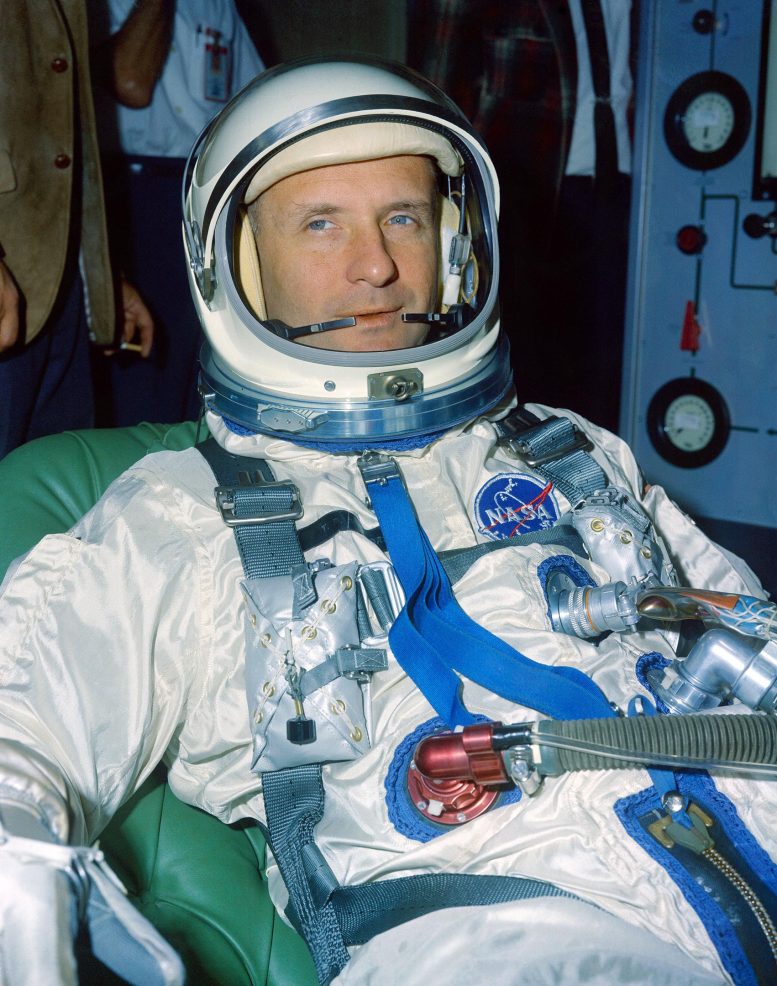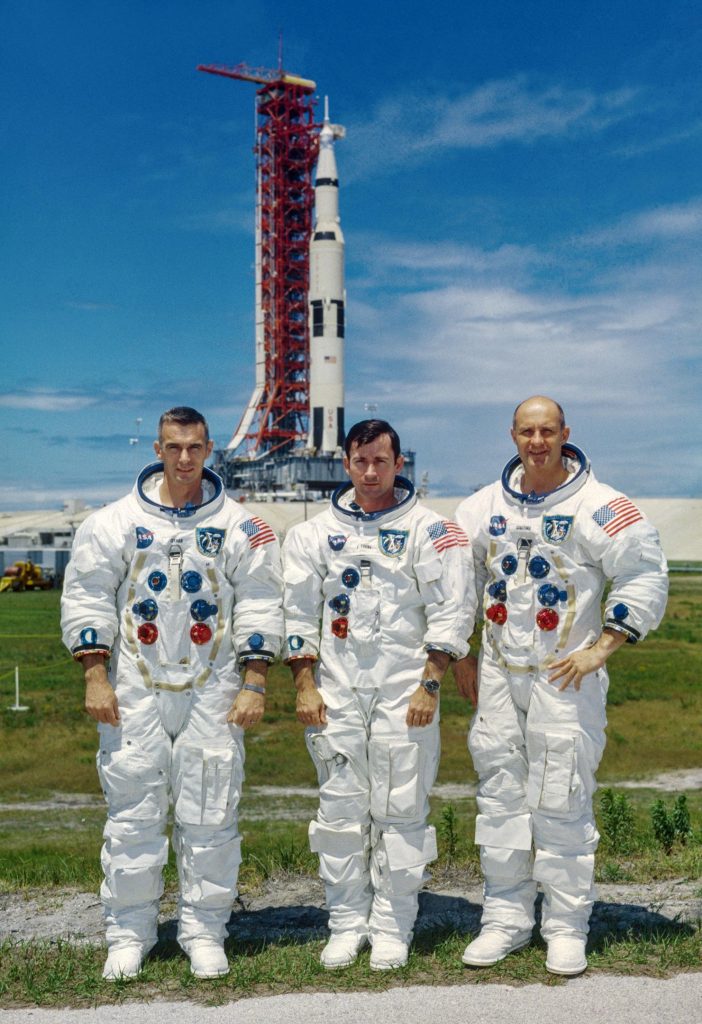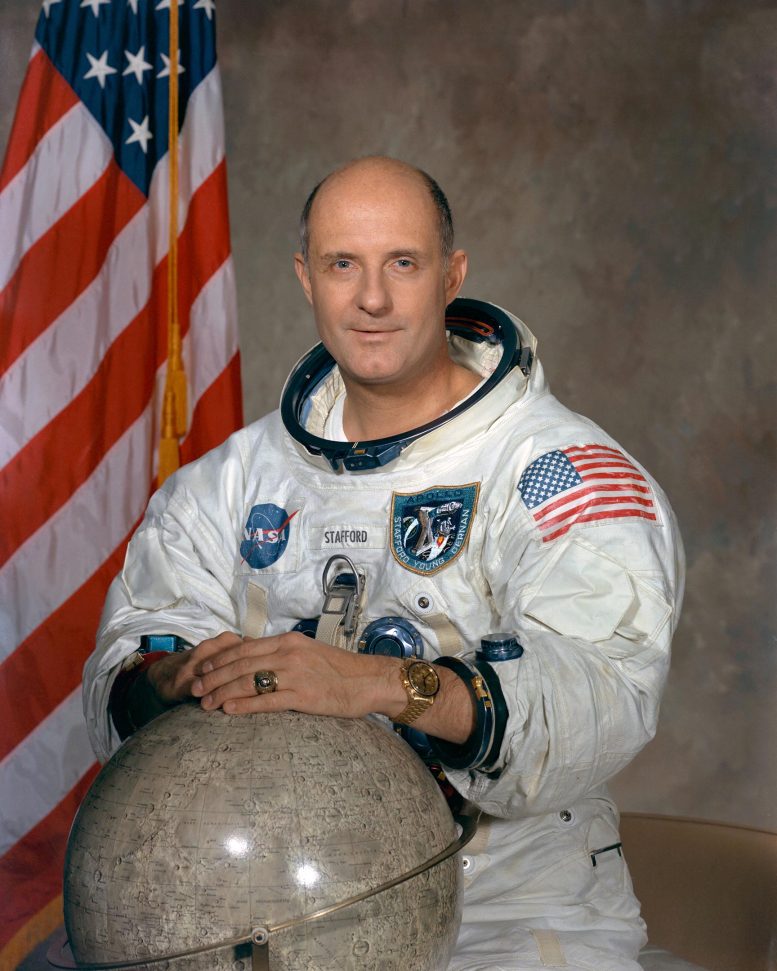Space Pioneer Thomas Stafford, Legendary Apollo 10 Commander, Dies at 93
Official NASA portrait of astronaut Thomas P. Stafford. Credit: NASA
Thomas P. Stafford, a luminary in the field of space exploration and a decorated U.S. Air Force general, passed away at 93 on Monday, leaving behind a legacy of pioneering achievements that spanned the early days of the space race to the era of international cooperation in space. Born in Weatherford, Oklahoma, Stafford’s journey took him from the plains of his home state to the vast expanse of space, where he played a crucial role in some of NASA’s most historic missions.
Stafford was at the forefront of America’s space exploration efforts, serving as a key figure in the Gemini and Apollo programs. He piloted the Gemini 6 and 9 missions, demonstrating extraordinary skill and courage, particularly when he navigated the Gemini 9 spacecraft back to Earth using only a pencil and paper after a system failure. His command of Apollo 10 marked a critical prelude to the moon landing, testing all the procedures and components that would enable the historic Apollo 11 mission to succeed.

Astronaut Thomas P. Stafford, the pilot of the Gemini-Titan 3 backup crew, is shown during suiting operations at Pad 16 at Cape Kennedy, Florida. Credit: NASA
Beyond his technical prowess and daring, Stafford was known for his efforts in fostering U.S.-Soviet space relations, culminating in the Apollo-Soyuz Test Project in 1975, which paved the way for future international collaborations in space. His post-NASA years were marked by continuous involvement in the aerospace community, where he contributed to strategic policy and safety improvements in space travel.
Stafford’s insights and experiences were invaluable in shaping the trajectory of space exploration. His memoirs and public speeches often reflected on the profound impact of viewing Earth from space, emphasizing the unity and fragility of our home planet. His awards and decorations, including the Congressional Space Medal of Honor, speak to his extraordinary contributions and the respect he garnered throughout his career.
As we remember Tom Stafford, we celebrate a man who not only pushed the boundaries of human potential in space but also inspired generations to look to the stars and dream of the possibilities. His legacy will continue to influence the realm of space exploration and beyond.

These three astronauts are the prime crew of the Apollo 10 lunar orbit mission. Left to right, are Eugene A. Cernan, lunar module pilot; John W. Young, command module pilot; and Thomas P. Stafford, commander. In the background is the Apollo 10 space vehicle on Pad B, Launch Complex 39, Kennedy Space Center, Florida. Credit: NASA
The following is a statement from NASA Administrator Bill Nelson on Monday’s passing of Thomas Stafford, a lifelong space exploration advocate, former NASA astronaut, and U.S. Air Force general:
“Today, General Tom Stafford went to the eternal heavens, which he so courageously explored as a Gemini and Apollo astronaut as well as a peacemaker in the Apollo-Soyuz mission. Those of us privileged to know him are very sad but grateful we knew a giant.
“Tom was critical to the earliest successes of our nation’s space program and was instrumental in developing space as a model for international cooperation. He also helped us learn from our tragedies and grow and reach for the next generation of achievement. He was intimately involved with the space program, sharing his thoughts and suggestions on NASA missions until the end of his life.
“Tom was a gentleman and a daredevil. He flew our first rendezvous in space on Gemini 6, and piloted Gemini 9’s path to Earth with pencil and paper when the spacecraft’s guidance computer failed in orbit. He commanded Apollo 10, the first flight of the lunar module to the Moon, a critical test flight that resulted in the successful landing on the Moon during the Apollo 11 mission. Tom also flew more than 100 different types of aircraft throughout his career as he pushed the edge of the envelope of our achievement in air and space. He was an extraordinary peacemaker who commanded NASA’s first rendezvous of an international spacecraft on the Apollo-Soyuz mission. His counterpart, General Alexei Leonov, became a best friend over the years. Tom gave Alexei’s eulogy in 2019 at the Russian state funeral.
“Tom’s dedication to NASA never wavered. In later years, he chaired a team to independently advise NASA on how to carry out President H.W. Bush’s space policy and completed the study ‘America at the Threshold’ about the nation’s potential future with humans in space. He also was co-chairman of the Stafford-Covey Space Shuttle Return to Flight Task Group that assessed NASA’s implementation of the Columbia Accident Investigation Board Space Shuttle Return to Flight recommendations.
“Our nation will be forever grateful to an explorer who never lost his sense of wonder. About his time in space, he said, ‘It changes you, oh sure. Changes your outlook…As you look back, you see a little blue and white baseball, actually, it’s smaller than a baseball. But it’s hard to envision that is where all the people you’ve known all your life are, where you went to school, your friends, your family. It’s also hard to envision that there are three billion people on that blue and white baseball.’
“Godspeed, Tom Stafford.”

Official NASA portrait of astronaut Thomas P. Stafford. Credit: NASA
Thomas P. Stafford, a luminary in the field of space exploration and a decorated U.S. Air Force general, passed away at 93 on Monday, leaving behind a legacy of pioneering achievements that spanned the early days of the space race to the era of international cooperation in space. Born in Weatherford, Oklahoma, Stafford’s journey took him from the plains of his home state to the vast expanse of space, where he played a crucial role in some of NASA’s most historic missions.
Stafford was at the forefront of America’s space exploration efforts, serving as a key figure in the Gemini and Apollo programs. He piloted the Gemini 6 and 9 missions, demonstrating extraordinary skill and courage, particularly when he navigated the Gemini 9 spacecraft back to Earth using only a pencil and paper after a system failure. His command of Apollo 10 marked a critical prelude to the moon landing, testing all the procedures and components that would enable the historic Apollo 11 mission to succeed.

Astronaut Thomas P. Stafford, the pilot of the Gemini-Titan 3 backup crew, is shown during suiting operations at Pad 16 at Cape Kennedy, Florida. Credit: NASA
Beyond his technical prowess and daring, Stafford was known for his efforts in fostering U.S.-Soviet space relations, culminating in the Apollo-Soyuz Test Project in 1975, which paved the way for future international collaborations in space. His post-NASA years were marked by continuous involvement in the aerospace community, where he contributed to strategic policy and safety improvements in space travel.
Stafford’s insights and experiences were invaluable in shaping the trajectory of space exploration. His memoirs and public speeches often reflected on the profound impact of viewing Earth from space, emphasizing the unity and fragility of our home planet. His awards and decorations, including the Congressional Space Medal of Honor, speak to his extraordinary contributions and the respect he garnered throughout his career.
As we remember Tom Stafford, we celebrate a man who not only pushed the boundaries of human potential in space but also inspired generations to look to the stars and dream of the possibilities. His legacy will continue to influence the realm of space exploration and beyond.

These three astronauts are the prime crew of the Apollo 10 lunar orbit mission. Left to right, are Eugene A. Cernan, lunar module pilot; John W. Young, command module pilot; and Thomas P. Stafford, commander. In the background is the Apollo 10 space vehicle on Pad B, Launch Complex 39, Kennedy Space Center, Florida. Credit: NASA
The following is a statement from NASA Administrator Bill Nelson on Monday’s passing of Thomas Stafford, a lifelong space exploration advocate, former NASA astronaut, and U.S. Air Force general:
“Today, General Tom Stafford went to the eternal heavens, which he so courageously explored as a Gemini and Apollo astronaut as well as a peacemaker in the Apollo-Soyuz mission. Those of us privileged to know him are very sad but grateful we knew a giant.
“Tom was critical to the earliest successes of our nation’s space program and was instrumental in developing space as a model for international cooperation. He also helped us learn from our tragedies and grow and reach for the next generation of achievement. He was intimately involved with the space program, sharing his thoughts and suggestions on NASA missions until the end of his life.
“Tom was a gentleman and a daredevil. He flew our first rendezvous in space on Gemini 6, and piloted Gemini 9’s path to Earth with pencil and paper when the spacecraft’s guidance computer failed in orbit. He commanded Apollo 10, the first flight of the lunar module to the Moon, a critical test flight that resulted in the successful landing on the Moon during the Apollo 11 mission. Tom also flew more than 100 different types of aircraft throughout his career as he pushed the edge of the envelope of our achievement in air and space. He was an extraordinary peacemaker who commanded NASA’s first rendezvous of an international spacecraft on the Apollo-Soyuz mission. His counterpart, General Alexei Leonov, became a best friend over the years. Tom gave Alexei’s eulogy in 2019 at the Russian state funeral.
“Tom’s dedication to NASA never wavered. In later years, he chaired a team to independently advise NASA on how to carry out President H.W. Bush’s space policy and completed the study ‘America at the Threshold’ about the nation’s potential future with humans in space. He also was co-chairman of the Stafford-Covey Space Shuttle Return to Flight Task Group that assessed NASA’s implementation of the Columbia Accident Investigation Board Space Shuttle Return to Flight recommendations.
“Our nation will be forever grateful to an explorer who never lost his sense of wonder. About his time in space, he said, ‘It changes you, oh sure. Changes your outlook…As you look back, you see a little blue and white baseball, actually, it’s smaller than a baseball. But it’s hard to envision that is where all the people you’ve known all your life are, where you went to school, your friends, your family. It’s also hard to envision that there are three billion people on that blue and white baseball.’
“Godspeed, Tom Stafford.”
